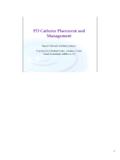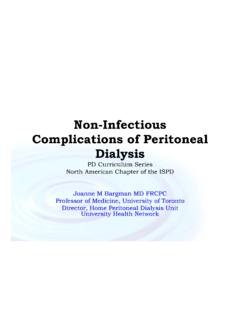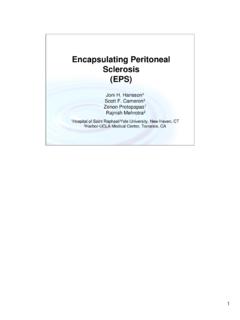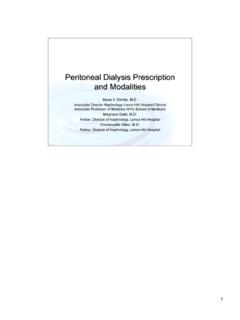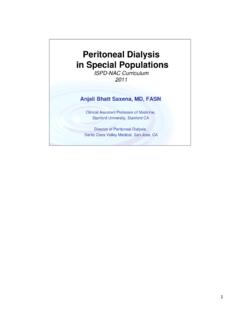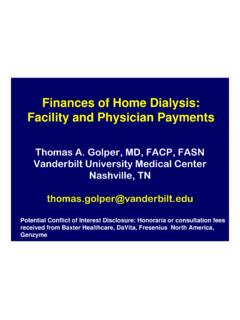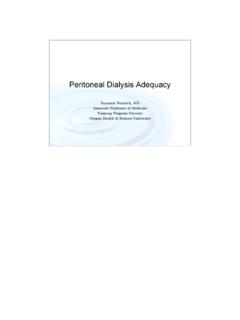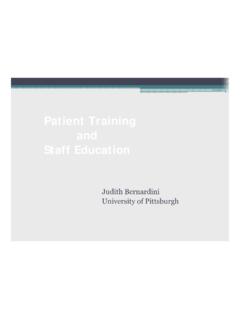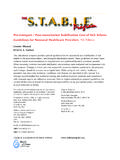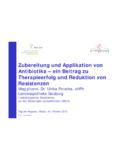Transcription of PD-Related Infections Recommendations
1 1PD- related Infections Recommendations Beth Piraino, MDProfessor of Medicine at University of Pittsburgh2 Introduction Peritonitis remains a major complication in PD Peritonitis contributes to mortality Peritonitis contributes to peritoneal membrane failure Continues to be a leading cause of technique failure3 This talk is based on ISPD Guidelines: Li PKT, Szeto CC, Piraino B, Bernardini J, Figueiredo A, Gupta A, Johnson DW, Kuijper EJ, Lye WC, Salzer W, Schaefer F, Struijk DG PDI 2010; 30: 393-4234 Learning objectives Learn to recognize and diagnose exit site Infections , tunnel Infections and peritonitis Learn the initial management of peritonitis and choices Learn subsequent management . Understand terminology for peritonitis Know how to calculate rates of of Peritonitis RateEvery program should regularly monitor infection rates, at a minimum on a yearly basis. Both exit site and peritonitis rates Causative organisms Antibiotic sensitivity Presumed etiology6 Reporting of Peritonitis RateThere are several ways to examine peritonitis within a program: As a rate either Months of at risk divided by # episodes # Infections divided by dialysis years at risk As % of patients who are peritonitis freefor a period of time As median peritonitis ratefor the '98'99'00'01'02'03 YEARPD Registry Data--DCI OaklandRATE: One episode per 75 monthsOr episodes per year at risk7 episodes in 6 patients in a program with 70 patients over the year with 44 years at riskExample of calculations:RATE.
2 # peritonitis episodes time at risk in group80%20%40%60%80%100%1999 2000 2001 2002 2003 2006 2007without peritonitiswith peritonitisData from DCI of Oakland PD RegistryFor this year only 9% of the patients (6/70) had a peritonitis episodeSince most patients did NOT have peritonitis (individual rate 0), the median rate for the program was zero. 9 Exit site and tunnel infectionsNormal looking exit site:Normal skin colorNo drainageNo crustingNo tenderness or swellingChronic exit site infectionCrusting, dark erythema1011 Tunnel infection Erythema, edema or tenderness along the subcutaneous pathway but often occult Almost always in conjunction with exit site infection but rarely occurs alone. S aureusand P aeruginosaoften causes of tunnel infection 12Rx for exit site/tunnel Infections The most serious and common exit site pathogens are S aureus and P aeruginosa and must be treated aggressively Oral antibiotic therapy is recommended, with the exception of MR S aureus 13 Therapy for exit site and tunnel Infections Empiric therapy should cover S aureus A penicillinase-resistant penicillin or first generation cehpalosporin can be used Avoid vancomycin unless MR Rifampin 600 mg each day can be added if S aureus and slow to resolve---but drug interactions14 Pseudomonas aeruginosa exit site and tunnel Infections Pseudomonas aeruginosa hard to treat Often require prolonged rx Can start with a quinolone Add second drug as needed Ceftazidime Cefepime Piperacillin etc15 Therapy for exit site and tunnel Infections Sonography of the tunnel may be useful to assess response to treatment Catheter removal should be considered If more than 3 weeks fails to resolve the infection If P aeruginosa is present consider early catheter removal Or if peritonitis develops16 Initial presentation of peritonitisSection three.
3 Initial presentation and management of peritonitisInitial Presentation and management of PeritonitisCloudy fluid: you cannot read print through the bag17 Presentation of peritonitis A PD patient presenting with cloudy effluent should be presumed to have peritonitis. This is confirmed with a cell count, 100 or more WBC per mcl, 50% or more polymorphonuclear white cells18 Differential diagnosis of cloudy effluent Culture positive infectious peritonitis Infectious peritonitis with sterile cultures Chemical peritonitis Eosinophilia of the effluent Hemoperitoneum Malignancy (rare) Chylous effluent (rare) Specimen taken from dry abdomen19 PeritonitisPD patients presenting with abdominal pain with no clear cause should also be presumed to have peritonitis until proven otherwise. 20 Interpreting the cell countThis is dependent on dwell time and amount of effluent in the abdomen. APD without a daytime exchange infuse 1 liter and wait 1-2 hours, use differential APD presenting at night will have short dwells, use differential21 Gram stain Generally negative However, may indicate yeast, which allows for rapid catheter removal Otherwise, don t rely on Gram stain for initial antibiotic coverage.
4 22 Other points Question the patient about causality Check on recent procedures Check exit site carefully Abdominal pain usually generalized Abdominal film/other imaging if bowel source suspected Free air suggests perforation 23 Specimen processing Culture negative peritonitis should not exceed 20% of cases Standard approach: inject 5-10 cc in each blood culture bottle Centrifuging 50 ml effluent and culturing sediment will increase the processing Rapid blood culture techniques (BACTEC, Septi-Check, BacT/Alert, Becton Dickinson) may speed up isolation and are best approach >75% of cases diagnosis is established in less than 3 days25 Empiric antibiotic selection:2005 guidelines recommended a center directed approach No change in 2010 guidelinesCephalosporinorvancomycin3rdge nerationcephalosporinoraminoglycosideAND 26 Method of delivery Intraperitoneal administration is superior to IV dosing for treating peritonitis Intermittent and continuous dosing are equally efficacious27 Adjunctive treatments Most fungal peritonitis follows course of antibiotics Use of anti-fungal prophylaxis during antibiotic rx may lead to less antibiotic related fungal peritonitis Each program will need to decide as to whether to give anti-fungal rx during rx of bacterial peritonitis.
5 28 Normal peritoneum for comparisonSubsequent management of peritonitisElectron micrograph of peritoneum in patient with peritonitis29 Once culture results and sensitivities available, adjust antibiotic therapy. See table for dosing at Increase dosing for those drugs excreted through kidney if RKF present (defined as >100 cc/d)30 management of peritonitis---refractory peritonitis Defined as failure to respond to appropriate antibiotics within 5 days Manage by removing peritoneal catheter. Replace PD catheter when appropriate based on patient s clinical condition31 Other terminology for peritonitis Recurrent: episodes within 4 wk of completion of therapy of prior episodes with a different organism Relapsingan episodes within 4 wk of completion of therapy of prior episode with the same or 1 sterile episode Repeat: a episode that occurs morethan 4 wk after completion of therapy of a prior episode with the same organismLi PKT, Szeto CC, Piraino B, Bernardini J, Figueiredo A, Gupta A, Johnson DW, Kuijper EJ, Lye WC, Salzer W, Schaefer F, Struijk DG PDI 2010.
6 30: 393-42332 Infectious indications for catheter removalRemove and wait to replaceSimultaneous replacement Refractory peritonitis Fungal peritonitis Relapsing peritonitis Chronic exit site infection33 Consider catheter removal for: Repeat peritonitis Mycobacterial peritonitis Multiple enteric organisms34 Coagulase negative Staphylococcus Due primarily to contamination Review patient s technique Mild; responds quickly to antibiotics However, may lead to relapsing peritonitis or repeat peritonitis due to biofilm. In such cases replace catheter35 Streptococcus and enterococcus Usaully curable with antibiotics but severe Best treated with IP ampicillin if sensitive Vancomycin-resistant: rx with ampicilin if sensitive, otherwise linezolid or quinupristin/dalfopristin36 Staphylococcus aureus Usually severe peritonitis Often related to catheter infection and if so often requires catheter removal Associated with colonization of the patient with S. aureus (nares, skin, etc) Rifampicin can be used as adjunct for prevention of relapse or repeat S aureus peritonitis 37 Pseudomonas aeruginosa Often related to catheter infection; catheter infection may be rather subtle (drainage that cultures positive) In such cases catheter removal required Two antibiotics should be used to treat38 Single Gram negative peritonitis May be from contamination, exit site infection, transmural migration across bowel wall (constipation, diverticulitis, colitis) SPICE (Serratia, Pseudomonas, and indol-positive organisms such as Providencia, Citrobacter and Enterobacter) have high risk of relapse Two antibiotics may be better than one.
7 39 Polymicrobial peritonitis If multiple enteric organisms, especially with anaerobes, risk of death is increased and surgical consultation is needed. If multiple Gram positive, usually responds to antibiotics. Possibly contamination. 40 Fungal peritonitis Serious Catheter removal should be immediate. Can often be picked up on presentation through Gram stain showing hyphae. Candida is most common fungal peritonitis Often follows antibiotic therapy 41 Mycobacteria causing peritonitis Infrequent but may be difficult to diagnose DNA PCR may be helpful Treat peritonitis with 4 durgs: rifampicin (IP), isoniazid, pyrazinamide and ofloxacin with pyridoxine. 42 Summary: PD related Infections Recommendations All programs should monitor rates. Assess quickly, institute treatment covering both Gram + and Gram negative organisms. Subsequent therapy should be tailored to organism and sensitivity. Don t hesitate to remove the PD catheter if refractory or relapsing.
8 Consider in repeat peritonitis, mycobacterial, and enteric peritonitis. Question #1 Your center had 7 patients on PD for entire year, 3 patients started during the year and had total of 18 months, and 3 left the program at 3 months, 6 months and 9 months During the year two patients had peritonitis--- one had S aureus and one had two episodes CNS peritonitis Which of the following is correct:43 Question #1: center s peritonitis rate is episodes per year at risk. This is great, nothing to worry about, no intervention center s peritonitis rate is episodes per year at risk. This is fine, no intervention center s peritonitis rate is episodes per year at risk. The patient with two episodes of CNS peritonitis should have his catheter replaced and this could be done safely as simultaneous center s peritonitis rate is episodes per year at risk. The patient with two episodes of CNS peritonitis should have his catheter replaced and this could be done safely as simultaneous procedure44 Question #1: Correct answer is - 4 Time in the program is 10 years.
9 3 episodes peritonitis so 3/10 = episodes per year at risk The patient with two episodes of CNS peritonitis within one year might well have infected biofilm on catheter so worth trying catheter replacement to prevent further episodes. Patient should also be re-trained. 45 Queston #2 A 28 year old woman on APD for 7 years presents with severe abdominal pain and cloudy effluent. She has never previously had peritonitis. Her cell count confirms peritonitis. Gram stain shows hyphae (yeast). The catheter exit site looks fine. The correct answer is:46 Question #2: anti-fungal therapy with fluconazole. Her PD catheter should be removed immediately without waiting for culture results. anti-fungal therapy with fluconazole as well as vancomycin and gentamicin to cover Gram positive and Gram negative organisms. Remove PD catheter immediately. anti-fungal therapy with fluconazole as well as vancomycin and gentamicin to cover Gram positive and Gram negative organisms Wait for the culture result before considering removing catheter.
10 Anti-fungal therapy with fluconazole as well as vancomycin and gentamicin to cover Gram positive and Gram negative organisms Wait for the culture result before considering removing catheter. Obtain a CT scan of the abdomen. 47 Question #2: Correct answer is - 2 This is fungal peritonitis which has very high mortality so catheter removal should be done immediately. Broad spectrum coverage needed because there may be enteric organisms as well as
